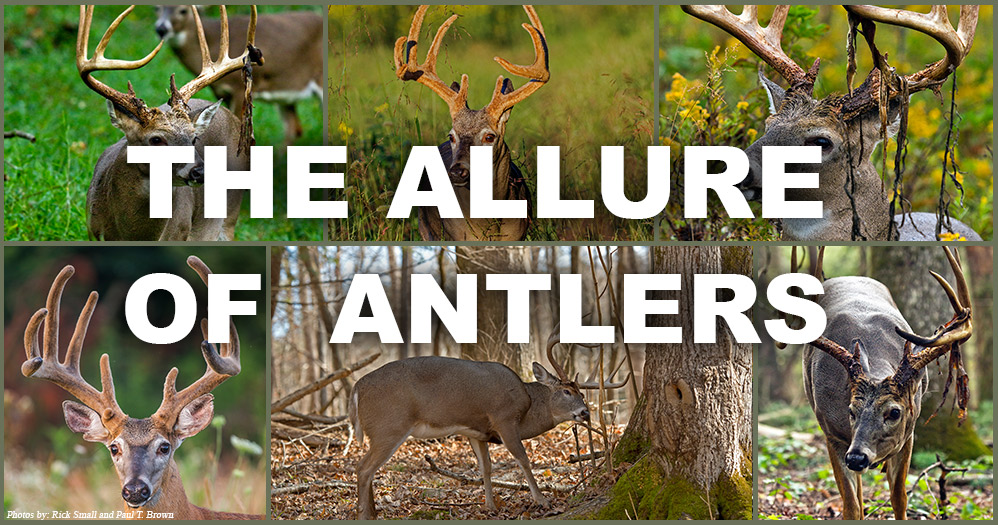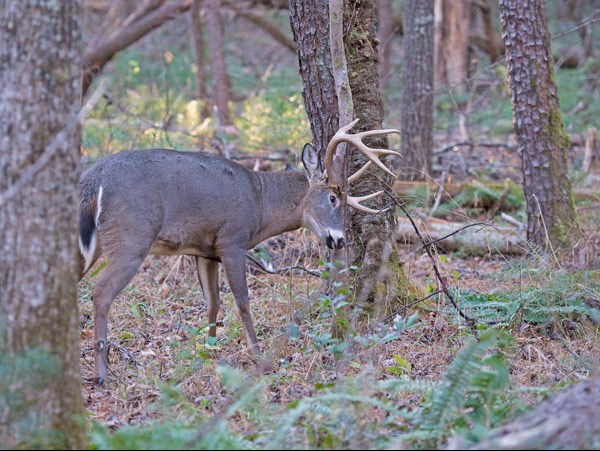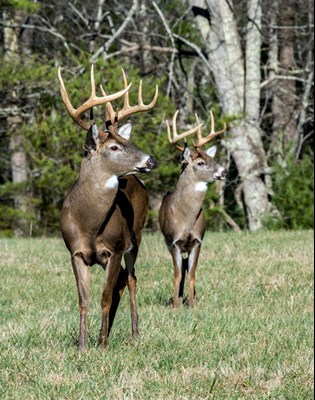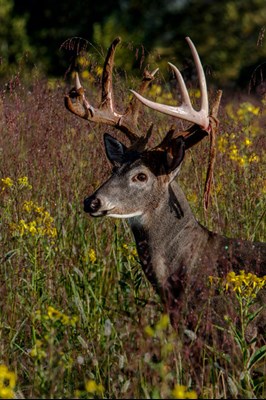Mississippi Outdoors: The Allure of Antlers
10/25/2017 8:31:13 AM
By MDWFP Deer Program Coordinator William T. McKinley


The following is a scenario that plays out every fall and winter throughout whitetail country.
The morning air is cold. The rising sun is beginning to burn off the frost covering the ground. The hunter wishes it would hurry and reach his frozen feet. He catches himself daydreaming, with the sun now shining on his face, wondering what the morning will bring. Suddenly, footsteps in the leaves jolt him back into reality. There, through the woods, a doe is running. From behind her, he hears the grunt of a buck. With adrenaline and instinct taking over, the hunter raises his weapon. A few minutes later he is admiring a buck sporting the antlers he has been dreaming about.
Many of you have experienced this situation. Have you ever wondered what those antlers really are and how they grew? In deer management today, growing big antlers is significant. We need a better understanding of the antler growth cycle to fully appreciate them.
Throughout history, antlers have held a magical appeal. First studied by Aristotle, they have been used for centuries in tribal rituals, as medicines, and even as aphrodisiacs in many cultures. Even today, they are proudly displayed by successful hunters.
So what are antlers and why are they so special? Antlers are the fastest growing normal tissue known to man, mimicking the growth of cancer cells. Deer go through a situation similar to osteoporosis when growing antlers. Their ribs become porous and weak because of decreased estrogen production. Dried antlers are composed of approximately 45 percent protein, 22 percent calcium, 11 percent phosphorus, and 1 percent fat. The remainder is comprised of carbon and trace amounts of other minerals. This is the reason that food plots should provide plants high in protein, calcium, and phosphorus (in other words clovers, peas, soybeans, and other legumes) during the growing season. Clovers planted in the fall provide these necessary nutrients during the early spring, just after antler shedding and at the time new antlers are initiating growth. A diet of 16 percent protein is generally considered optimum for antler development, although as low as 10 percent may be adequate.
The antler growth cycle, called antlerogenesis, is controlled by both neural and endocrine (hormone) factors. The timing of antlerogenesis is controlled by photoperiod or the amount of light in a day. Increasing daylight length initiates, the hormone production that begins antler growth. A study was conducted that kept deer in a room with a controlled light source. The normal year’s light cycle was “sped up,” resulting in three complete antler cycles in a year by one deer. In contrast, when the normal year’s light cycle was “slowed down” the antler cycle was delayed up to two years.

The timing of antler growth varies dramatically from north to south. In Mississippi for instance, antlers begin to grow much later than in northern states. In the tropics, where day length does not change, deer grow antlers at all times of the year.
Deer begin to grow new antlers almost immediately after the old antlers are shed. A brief increase in testosterone is needed to initiate antler growth. Then testosterone diminishes and the buck becomes temporarily infertile. Once the antlers begin to grow, many hormones are needed to complete the growth process.
Growing antlers are covered in a fuzzy skin called velvet. Rich in blood vessels, this tissue is very sensitive to the buck. As antlers approach maturity, the blood vessels begin to close. Testosterone once again increases, causing the antlers to harden or mineralize. At this time, the velvet begins to itch, prompting the buck to rub his antlers to remove it. The shedding of velvet usually happens quickly, sometimes in just hours. When the velvet is shed, the antler is bone, affixed to the skull via the pedicel. The buck, which has been infertile since shortly after shedding his old antlers, is now ready to breed.
Antler size generally increases until a buck reaches maturity at 5–7 years of age. Average antler mass increases four-fold from 18 months to 2.5 years of age and nine-fold from 18 months to 5.5 years. Antler points, main beam length, and antler spread generally increase with age. Approximately 80 percent of bucks will mature with 8 points. Some never attain 8 points and others may grow 30 or more.


Antlers are classed as typical (points generally arising at regular intervals from the top of the main beams) or non-typical (points arising from locations other than the top of the main beam or at irregular intervals). The frequency of non-typical points increases in older males. In southern herds, body mass and antler development of 1.5-year-old males are related directly to date of birth. The later they are born within the year, the smaller the body weight and antlers.
So the next time you are daydreaming about that buck of a lifetime, just imagine the possibilities.
Here are some interesting results from past studies on antlers:
- The normal hormonal cycle results in the buck going through puberty each year.
- If you castrate a fawn buck before the pedicels are fully developed, he will never grow antlers.
- If you castrate an adult buck in velvet, the antlers will continue to grow at a much slower rate but will never harden.
- If you castrate an adult buck with hardened antlers, he will promptly shed them. The following spring, he will grow new antlers that will never harden. The last two scenarios result in a “cactus buck.”
- Finally, if you graft part of the pedicel to another body part, an antler will grow there.
To subscribe to Mississippi Outdoors magazine, call toll-free 1-888-874-5785.









